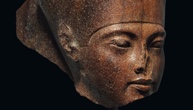
Saturday 6th July 2019 - Della Bentham

A 3,000-year-old stone sculpture of Tutankhamun sold for £4.7 million on Thursday despite calls from Egypt to stop the auction with questions surrounding its provenance.

Image From Christie's
Last month renowned auction house Christie's announced the sale of some ancient Egyptian artefacts which included a 3,000-year-old stone sculpture of Tutankhamun was set to take place in July. This rare bust is the first to come to market since 1985 and obviously attracted a lot of attention.
At the time of publicising the catalogue, Christie's informed the Egyptian authorities of the artefact owing to the fact they strictly adhere to bilateral and international laws on cultural property and patrimony.
Egypt’s antiquities ministry then announced they would seek to stop the sale until provenance of the item had been proven.
The brown quartzite statue known as the Amun Head depicted the boy king as the god Amen. It is alleged to have been stolen from Egypt according to the Egyptian Ministry who wanted it to be returned to its homeland.
Despite these protests from Egypt Christie's pressed ahead with the sale of the object, stating that the bust had never been subject to previous investigations or allegations about its origin. A spokesperson for Christie's said:
"We recognise that historic objects can raise complex discussions about the past, yet our role today is to work to continue to provide a transparent, legitimate marketplace upholding the highest standards for the transfer of objects.
"There is an honourable market for ancient art and we believe it is in the public interest that works come out into the open with the opportunity for them to be researched, as well as seen and enjoyed by global audiences."
Christie's say they had gone through all of the necessary processes to ensure its origins and that they would not sell any work where there was no clear title of ownership and thorough understanding of provenance.
Over the last five years, Egypt has managed to successfully recover over 1,500 ‘stolen’ antiques from the Western world. Many items were stolen from institutions including museums and looted from tombs.
The issue of provenance has been raised a few times in recent years and begs the question should the sale of such antiquities be banned altogether?
Monica Hanna an Egyptologist says:
“It needs to be continuously communicated to the West that it is a similar trade to that of blood diamonds.”
In 2017 it came to light that gangs in Egypt used children to climb down illegally dug shafts to pillage archaeological sites. Italian authorities then managed to confirm that Isis in Libya had been selling items stolen from archaeological sites to crime groups in Southern Italy in exchange for weapons. The sale of ‘legal’ antiquities, unfortunately, helps to feed and cover up the illegal market, hence the trade being likened to blood diamonds.
Despite the protests, the sale went ahead, and after a very brief bidding process, the piece in question sold for £4.7 million.
It’s clear that there is a demand for such antiquities in the market, but should such items of cultural heritage be returned to their homeland, or should they be sold legally on the international market for all to enjoy?